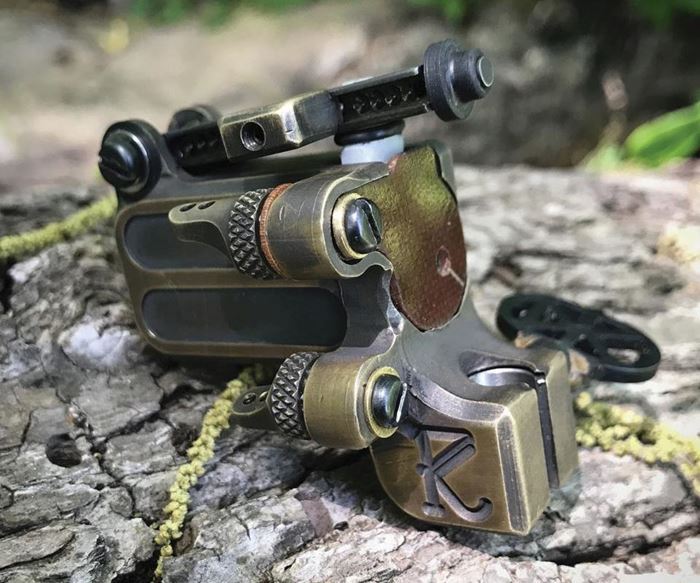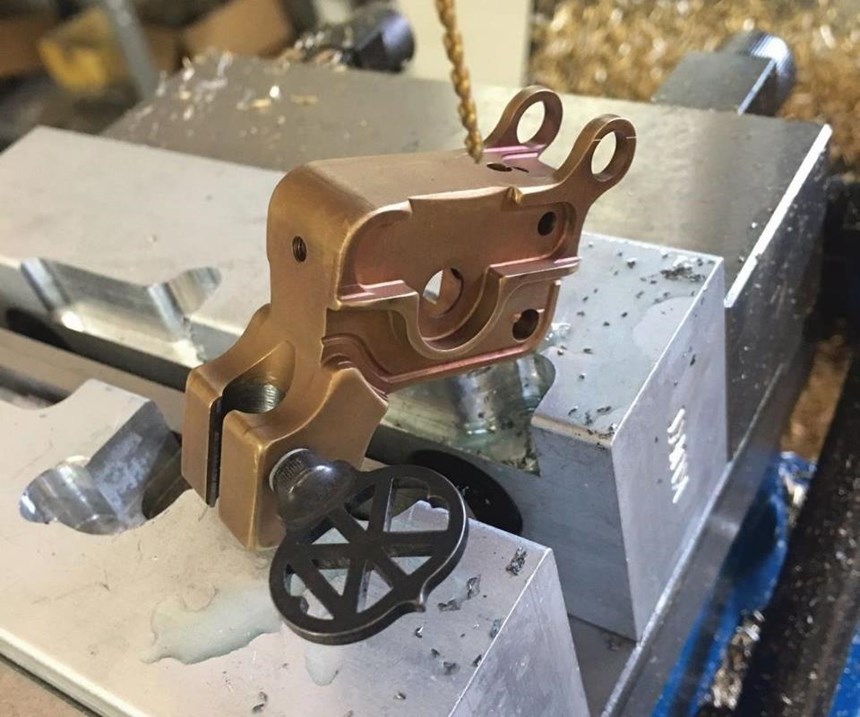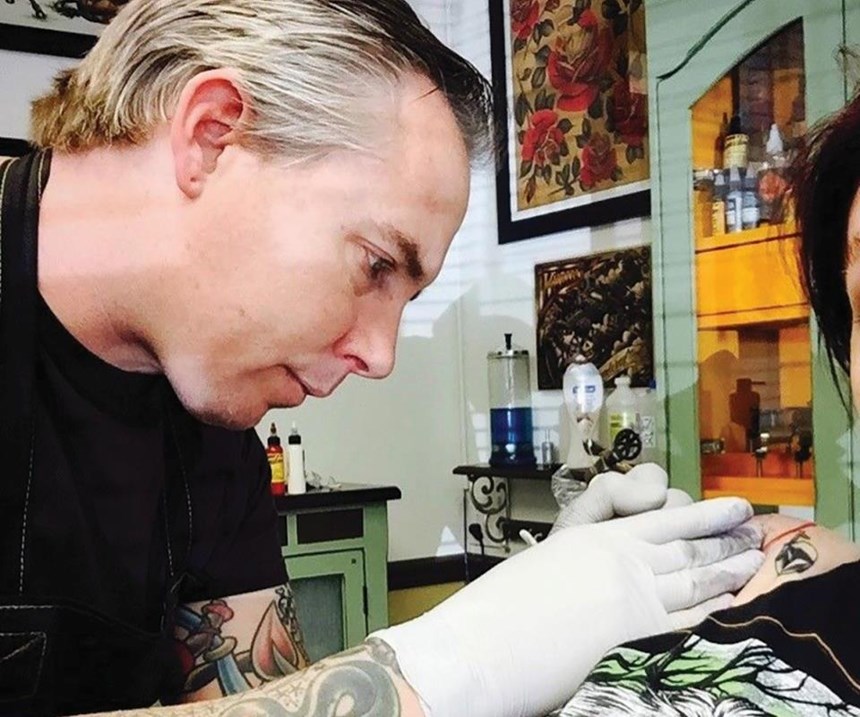Milling Machine’s CNC Leaves a Mark
When the prototyping process wasn't able to keep pace with creativity, installing a Heidenhain CNC on this manufacturer's Webb milling machine enabled faster machining, prototyping for this tattoo-machine developer.
Share




Takumi USA
Featured Content
View More
Hwacheon Machinery America, Inc.
Featured Content
View More



Manually designing and developing tattoo machines takes time. This can be a serious roadblock for a creative person like Dan Kubin, who needed a faster way to machine and manufacture his prototypes. By purchasing an Acu-Rite MillPwr G2 CNC from Heidenhain Corp. (Schaumburg, Illinois) and installing it on a new milling machine, Mr. Kubin was able to cut the time he spends making prototypes by a day or more, and increase the options on and availability of his products.
“I’ve really been able to up my game,” he says.
Mr. Kubin became interested in the art in 2005 while he was serving as a machinist and welder in the U.S. Air Force. He practices it two days a week at a private studio. Also as a maker of the small machines used to apply tattoos, he spends the rest of his week at his home workshop in Independence, Missouri, making such machines for customers around the world. These rotary-style machines sell out within hours of his uploading their listings on Sunday nights to his website, dankubin.com. They are described as reminiscent of “steampunk” style, a retro-futuristic take on technology that often incorporates bright brass and copper. “If it is steampunk, that is unintentional. All I can say is that I like this look, as well as the use of brightly colored finishes, and working with brass and copper,” he says.
When Mr. Kubin was designing and developing his machines manually, he outsourced the machining in bulk. This system was unsustainable, however, due to the number of different designs he makes, combined with the custom nature of the work. His constantly evolving creativity was frustrating for everyone involved, he says.
Instead of spending a day and a half using a small, hobbyist-type benchtop mill with a digital readout and a rotary table to create the basic frame of new prototypes, Mr. Kubin decided to buy a milling machine with a CNC so he could develop parts exactly the way he wanted within his own timeframe.
After visiting Accurate Measurement Systems (AMS) in St. Louis, Missouri, last fall, he bought a demo Webb 4EVS-XL-HC-220V milling machine right off the floor. The two-axis machine has a “turbo” power knee and enables Mr. Kubin to draw ideas in CAD and load the DXF files directly into the MillPwr control via USB.
“Since his market demand continues to swell due to the appearance and performance of his rotary tattoo machines, he felt a driving force to acquire something that could get his ideas to the CNC shop quicker. The G2 has allowed him to do that,” says AMS’s Ed Albeitz.
Mr. Kubin says that using the new milling machine and CNC allows him to create his first prototype tattoo machine in half a day, and since he programs as he goes, a second one takes just an hour. Features such as the mill’s quill and W axis have been key to speeding up the prototyping process, he says. He can move the machine’s knee up and down, manipulating the W axis without changing the zero setting. The G2 CNC compensates for that, and nothing needs to be reset, he says. The CNC also uses Acu-Rite Senc 150 1-micron (0.00005-inch) linear encoders for positioning and feedback.
“I can now do more lines on a horizontal, vertical or an angle; arcs; and pockets than before,” Mr. Kubin says. “I am currently working on a project that requires quite a few mating pieces that have very specific arcs. I would never have been able to prototype this with this current level of accuracy before.”
Another key feature of the CNC is a circle function, which he uses to make certain pockets. “This function allows me to not have to have a drill bit or an end mill, and I still can get the pocket done, since I can easily make a box come up,” he says.
Mr. Kubin adds that the G2’s tool probe and the ease with which he can view and change the program have helped him create detailed prototypes quickly. For example, he can now touch off his part and calculate where the datum will be right on the CNC. He also says that he can easily look at the program and make modifications, incorporating all the ideas in his head.
Mr. Kubin says that the milling machine and CNC have enabled him to create a lineup of tattoo machines that blows everything else out of the water.
“I’ve really been able to hone in and precisely cut out exactly what I want. And when I mess up, I can just change my program a little bit and start over easily,” he says.
Mr. Kubin still uses a local machine shop for mass production, but the quickness and ease with which he can create prototypes has saved both time and money. “I’d say my new milling machine has made its money back 10 times over,” he says.
He often brings his prototypes to his studio and tries them out on willing customers. “Part of tattooing for me is strong product development. You really don’t know what a machine is going to do until you put the needle to the skin,” he says. “A lot of my success is due to my wonderful and willing customers.”
Mr. Albeitz adds, “Although Dan did not invent the rotary tattoo machine, he has developed the business of designing and producing them as a true art form. As one might expect, AMS does not normally deal with anyone in this particular line of work, but with the Acu-Rite MillPwr G2 married to the right machine tool, just about anything is possible.”
Related Content
4 Commonly Misapplied CNC Features
Misapplication of these important CNC features will result in wasted time, wasted or duplicated effort and/or wasted material.
Read MoreInverting Turning and Five-Axis Milling at Famar
Automation is only the tip of the iceberg for Famar, which also provides multitasking options for its vertical lathes and horizontal five-axis machine tools.
Read More6 Machine Shop Essentials to Stay Competitive
If you want to streamline production and be competitive in the industry, you will need far more than a standard three-axis CNC mill or two-axis CNC lathe and a few measuring tools.
Read MoreCNC Machine Shop Honored for Automation, Machine Monitoring
From cobots to machine monitoring, this Top Shop honoree shows that machining technology is about more than the machine tool.
Read MoreRead Next
Registration Now Open for the Precision Machining Technology Show (PMTS) 2025
The precision machining industry’s premier event returns to Cleveland, OH, April 1-3.
Read More5 Rules of Thumb for Buying CNC Machine Tools
Use these tips to carefully plan your machine tool purchases and to avoid regretting your decision later.
Read MoreBuilding Out a Foundation for Student Machinists
Autodesk and Haas have teamed up to produce an introductory course for students that covers the basics of CAD, CAM and CNC while providing them with a portfolio part.
Read More



































.jpg;maxWidth=300;quality=90)
















